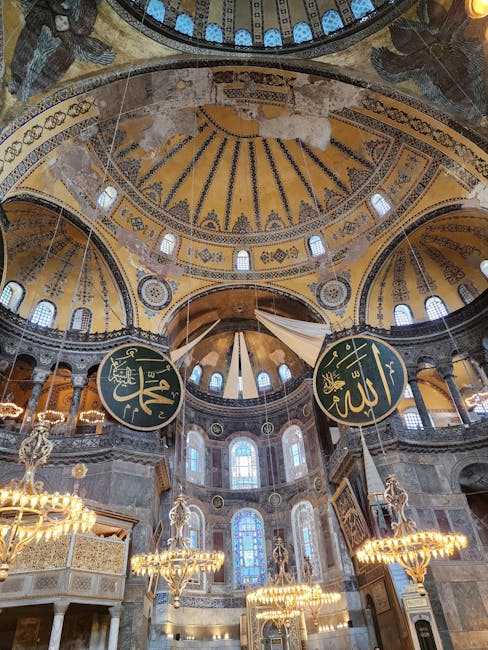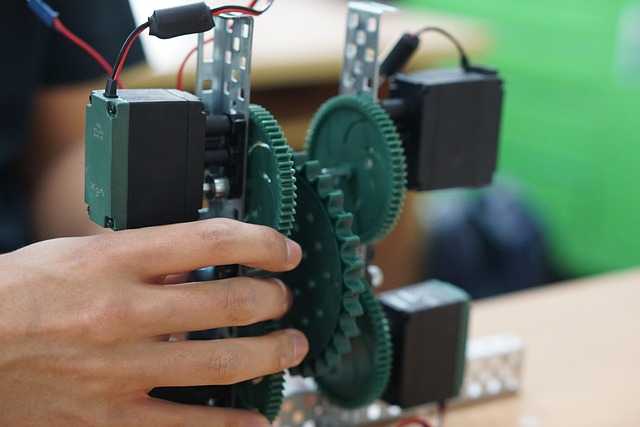Table of Contents
- Exploring the Rich History and Cultural significance of Mosaic Art
- techniques and Materials: Crafting stunning Mosaic Masterpieces
- creating Your Own Mosaic Artwork: Step-by-Step Guide
- Inspiring Contemporary Mosaic Artists to Watch and Follow
- Q&A
- The Conclusion


Exploring the Rich History and Cultural Significance of Mosaic Art
Mosaic art carries with it a profound ancient narrative, tracing back thousands of years to ancient civilizations. The earliest known use of mosaics can be traced to the Mesopotamians around 3000 BCE, where small stones and tiles were carefully arranged to create intricate patterns and images. These early examples served not only decorative purposes but were often embedded into the structures of temples and public buildings, reflecting the culture’s reverence for divine imagery and craftsmanship. As civilizations evolved, so did the art form, reaching remarkable heights in ancient Greece and Rome, where mosaics adorned floors and walls of villas, showcasing elaborate scenes from mythology and everyday life.
The techniques have diversified throughout history, with artisans employing a variety of materials-glassy tesserae, colored stones, and even shells-to enhance their work. Basilicas and cathedrals, especially during the Byzantine period, became canvases for monumental mosaics depicting religious iconography. These mosaics weren’t merely decorative; they played a crucial role in storytelling, providing a visual education for a largely illiterate populace. The effective use of light and color added a dynamic element, transforming the spiritual ambiance within these sacred spaces.
Today, mosaic art continues to resonate with cultural significance, adaptable to modern artist expressions while preserving traditional elements. Contemporary mosaics can be found in public art installations, community projects, and even individual homes, demonstrating its universal appeal. Artists now blend ancient techniques with modern themes, addressing issues such as identity, culture, and social commentary through their work. Additionally, the resurgence of mosaic art in urban areas has fostered community engagement, as local artists collaborate with residents to transform spaces into vibrant visual narratives.
Highlighting the importance of mosaic art, we can explore its cultural significance through a simple table showcasing diffrent periods and styles:
| Period | Key Characteristics | Prominent Materials |
|---|---|---|
| ancient Mesopotamia | Geometric patterns and simple motifs | Stones, clay |
| byzantine Era | Religious themes with gold and rich colors | Glass tesserae, gold leaf |
| Renaissance | Naturalistic representation and classical themes | Marble, colored stones |
| Modern Day | Mixed media and abstract designs | Recycled materials, ceramics |
This artistic medium not only bridges the past with the present but also fosters a connection between communities, demonstrating that mosaic art is not just about aesthetic appeal; it is an enduring expression of human creativity and storytelling that adapts and thrives across cultures and epochs.
Techniques and Materials: Crafting Stunning Mosaic Masterpieces
To create breathtaking mosaic art, selecting the right materials is fundamental. Glass, ceramics, and natural stone are some of the most popular options. Each material offers its unique aesthetic, durability, and texture.use glossy tiles for vibrant reflections or matte stones for a more subdued and rustic appearance. choosing a combination of materials can introduce depth and contrast, enhancing the overall visual impact of your artwork.
Beyond the physical materials, the techniques employed in your mosaic work can substantially influence the final product. smalti (a type of glass tile) and premade kits offer interesting textures and colors,while cutting your tiles from existing ceramics gives a personalized touch. Pay attention to the following techniques:
- Direct Method: Gluing tiles directly onto the surface without the use of a substrate.
- Indirect Method: Assembling tiles on a temporary adhesive surface, then transferring it to the final location.
- Nipping: Using nippers to break tiles into smaller pieces for intricate designs.
For those looking to explore the intersection of technology and traditional artistry, consider incorporating digital tools into your process. Design software can help plan your layout, making it easier to visualize color schemes and patterns before you commit to the materials. Moreover,innovations in materials,such as recyclable tiles and eco-amiable adhesives,not only enhance the artistry but also align with enduring practices. Using a mix of traditional and modern approaches can yield stunning results that resonate with both contemporary and classic aesthetics.


Creating Your Own Mosaic Artwork: Step-by-Step Guide
Creating your own mosaic artwork is an exciting journey that transforms simple materials into vibrant pieces of art. Start by gathering your materials, which can include tiles, glass shards, ceramics, or even natural elements like pebbles and shells. For your work surface,consider using a sturdy board or canvas that can support the weight of your chosen materials. Don’t forget to have adhesive (like tile adhesive or glue) and grouting materials ready as well!
Once you have your materials, sketch out a design on paper before transferring it to your surface. This preliminary sketch will act as a roadmap for your mosaic. Use different colors and shapes to give depth and texture to your design.When you’re ready, begin placing the pieces onto your board without gluing them down initially, allowing for adjustments. this allows you to visualize how your final piece will look and make any necessary changes before the commitment.
After you’re satisfied with the layout, start adhering the pieces one at a time. Apply a small amount of adhesive to the back of each piece and press it firmly onto the surface. as you work, take care to leave tiny spaces between tiles to accommodate the grout later. Once you’ve covered your design, let the adhesive cure according to the manufacturer’s instructions.This crucial step ensures a solid base for your artwork.
it’s time to grout your mosaic! Mix your grout according to the instructions and apply it over the tiles using a rubber spatula or your fingers. Make sure to fill in all the gaps between the pieces. After allowing the grout to sit for a few minutes, wipe off any excess with a damp sponge. You can finish your artwork with a sealant to protect it, especially if it will be displayed outdoors. Your unique creation is now ready to shine!


Inspiring Contemporary Mosaic Artists to Watch and Follow
Contemporary mosaic art has evolved significantly, blending traditional techniques with modern themes and materials. Today’s mosaic artists are pushing boundaries, creating stunning pieces that challenge perceptions and engage viewers. Here are a few remarkable artists making waves in the mosaic community.
- Tesserae by Sophia: Renowned for her intricate designs, Sophia combines glass, ceramics, and found objects to create vibrant mosaics that often depict nature and storytelling. Her work emphasizes sustainability, using recycled materials whenever possible.
- Fabienne Rivory: A French artist whose work reflects on urban life, Fabienne’s city-inspired mosaics incorporate elements of pop culture and contemporary issues.Her bold color palette and innovative techniques breathe new life into traditional forms.
- David Galletly: Focusing on the human figure, David’s mosaics explore themes of emotion and connection. Utilizing a mix of materials, including stone and glass, his pieces invite viewers to reflect on their own experiences and relationships.
- Bethany koby: An artist and educator, Bethany is known for her community projects that encourage artistic expression among diverse groups. Her large-scale installations often draw on local history and culture, fostering connection through art.
These artists exemplify the dynamic nature of modern mosaic art.They are not only skilled craftsmen but also storytellers and innovators, each with their unique voice. By following their journeys, art enthusiasts can gain insights into the emerging trends within this captivating art form.
| Artist Name | Specialty | Materials Used |
|---|---|---|
| Sophia | Nature & Storytelling | Glass, Ceramics, Recycled Objects |
| Fabienne Rivory | Urban life | Mixed Media, Bold Colors |
| David Galletly | Human Emotion | Stone, Glass |
| Bethany Koby | Community Projects | Variety, Local Materials |
Engaging with these contemporary mosaicists can provide inspiration and insight into both artistic techniques and the broader themes they tackle in their work. By exploring their portfolios and following their careers, art lovers can stay up-to-date with the latest in mosaic creativity and innovation.
Q&A
Q&A About mosaic Art
Q1: What is mosaic art?
A1: Mosaic art involves creating images or patterns by assembling small pieces of materials such as glass, stone, or ceramic tiles. These individual fragments,when placed together,form a cohesive design that can be intricate and vibrant. This ancient art form can be found in various cultures, often adorning public spaces, museums, and private collections.
Q2: What materials are commonly used in mosaic art?
A2: Traditional mosaic art typically utilizes materials like tesserae, which can be made from small bits of colored glass, marble, or stone. Today, artists also incorporate modern elements such as found objects, mirror shards, and even recycled materials, expanding the boundaries of this versatile medium.
Q3: How do you create a mosaic piece?
A3: Creating a mosaic piece begins with selecting a design or pattern.After sketching the layout on a surface, the artist adheres the chosen materials piece by piece, using a strong adhesive. Once the base is covered, grout is applied to fill the spaces between the elements, enhancing the overall appearance and adding durability.
Q4: What are some historical examples of mosaic art?
A4: Mosaic art has a rich history, with notable examples including the intricate Roman mosaics found in Pompeii and Herculaneum, which depict scenes from mythology and daily life. Additionally,Byzantine mosaics,with their golden backgrounds and religious themes,are celebrated for their stunning beauty,seen extensively in churches like Hagia Sophia.
Q5: Can anyone create mosaic art?
A5: Absolutely! Mosaic art is accessible to people of all skill levels. Beginners can start with simple projects using pre-cut materials, while experienced artists can experiment with complex designs and innovative techniques. There are many resources, workshops, and online tutorials available to guide newcomers in their mosaic journey.
Q6: What is the significance of mosaic art in modern times?
A6: In modern times,mosaic art continues to be celebrated for its ability to blend tradition with contemporary aesthetics. Artists use it to express personal and social themes, transforming public spaces with vibrant murals and installations. Mosaic art also promotes a sense of community, as collective projects often bring people together in collaborative creative efforts.
Q7: how can I get involved in mosaic art?
A7: Getting involved in mosaic art can be as simple as joining a local class or community workshop.You can also create your own projects at home by gathering materials and tools from craft stores. Online platforms and social media groups dedicated to mosaic art can provide inspiration, tips, and a community to share your work with fellow enthusiasts.
Q8: What tips do you have for beginners interested in mosaic art?
A8: Start small! Choose a simple project that doesn’t overwhelm you, and gradually work your way up to more complex designs. Consider your workspace and gather all necessary materials beforehand. Don’t be afraid to experiment with colors and shapes-embrace the creative process! remember that mistakes can lead to unique and beautiful results, so enjoy the journey.
